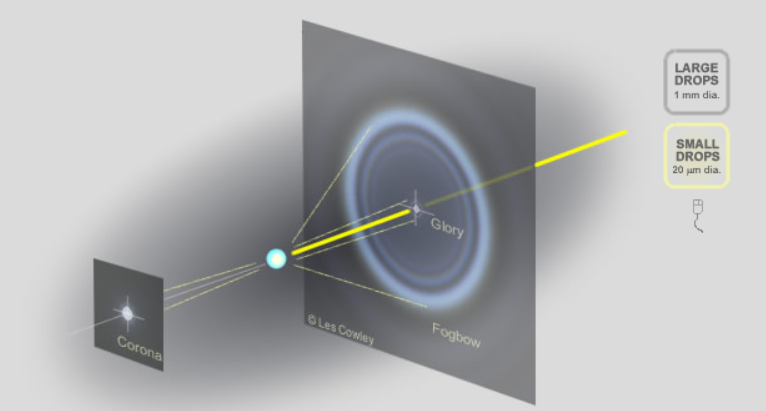Light and Water Droplets
Light and Water Droplets: Exploring the Phenomenon
When it comes to atmospheric optics, one fascinating topic that captivates our attention is the interaction between light and water droplets. Whether it's clouds, fog, mist, or raindrops, these tiny droplets have a profound impact on how light behaves in our atmosphere. In this article, we will delve deeper into the intricate details of light scattering by small and large water droplets, uncovering the mesmerizing patterns they create in the sky.
Clouds, fog, and mist consist of small water droplets that are so minuscule that the wave nature of light becomes significant when it interacts with them. Unlike larger raindrops, which only refract or reflect light, these small droplets scatter or diffract light waves in all directions, resulting in a captivating ringed pattern that blankets the sky. Although we can only see the brightest parts of this pattern, such as the colorful corona encircling the sun, the ringed glory directly opposite the sun, and the ghostly white fogbow, its presence adds an enchanting touch to our atmospheric scenery.
In contrast, raindrops are significantly larger than cloud droplets, ranging from 10 to 1000 times their size. Due to their size difference, the diffraction effects of raindrops are comparatively minimal. Consequently, raindrops do not exhibit significant coronae or glories like their smaller counterparts. Instead, they form a distinct and well-defined rainbow, showcasing the mesmerizing beauty of nature's color spectrum.
To better understand the differences between light scattering by cloud droplets and raindrops, we can refer to accurate simulations created by IRIS. By comparing the scattering patterns of different droplet sizes, we gain valuable insights into how these minute variations can alter the optical phenomena we observe in the sky.
Intriguingly, the phenomenon of light and water droplets extends beyond the visible spectrum. While we are familiar with the vibrant colors of rainbows and fogbows, there are also other optical phenomena that occur in the infrared and ultraviolet regions. Exploring these lesser-known aspects of atmospheric optics opens up a whole new world of marvels and discoveries.
Understanding the behavior of light in the presence of water droplets is not only a matter of scientific curiosity but also has practical applications. Atmospheric scientists and meteorologists rely on this knowledge to study and predict weather patterns, as well as to interpret and analyze satellite imagery. By comprehending how light interacts with water droplets, we gain valuable insights into the dynamics of our atmosphere and the processes that shape our weather systems.
Moreover, the study of light and water droplets also finds relevance in various artistic endeavors. From capturing the ethereal beauty of a rainbow on canvas to creating captivating photographs of foggy landscapes, artists have long been inspired by the interplay between light and water droplets. By understanding the underlying physics, artists can harness these optical phenomena to evoke emotions and create visually stunning works of art.
In conclusion, the interaction between light and water droplets is a captivating topic within atmospheric optics. From the intricate scattering patterns produced by small droplets in clouds, fog, and mist to the well-defined rainbows formed by larger raindrops, these optical phenomena add depth and beauty to our sky. By delving deeper into this subject, we not only gain a better understanding of the natural world but also uncover practical applications and artistic inspirations that stem from this fascinating interplay between light and water droplets.

Compare light scattering by small and large water droplets
Clouds, fog and mist droplets are small enough that when light interacts with them its wave nature is significant. Light is not simply refracted or reflected at the drop surface. Instead, its waves are scattered or diffracted in all directions to produce a wildly oscillating ringed pattern right around the sky. We see only the pattern's brightest parts; the coloured corona around the sun, the ringed glory directly opposite the sun and a large ghostly white fogbow.
Raindrops are 10-1000X larger than cloud droplets and their diffraction effects are consequently small.. Their coronae and glories are insignificant and instead of a diffuse fogbow they form a sharp rainbow.
Mouse over the droplet size panels to compare cloud droplets and raindrops. The scattering patterns are accurate simulations made by IRIS.
Note: this article has been automatically converted from the old site and may not appear as intended. You can find the original article here.
Reference Atmospheric Optics
If you use any of the definitions, information, or data presented on Atmospheric Optics, please copy the link or reference below to properly credit us as the reference source. Thank you!
-
<a href="https://atoptics.co.uk/blog/light-and-water-droplets/">Light and Water Droplets</a>
-
"Light and Water Droplets". Atmospheric Optics. Accessed on May 7, 2024. https://atoptics.co.uk/blog/light-and-water-droplets/.
-
"Light and Water Droplets". Atmospheric Optics, https://atoptics.co.uk/blog/light-and-water-droplets/. Accessed 7 May, 2024
-
Light and Water Droplets. Atmospheric Optics. Retrieved from https://atoptics.co.uk/blog/light-and-water-droplets/.